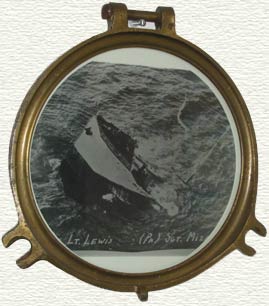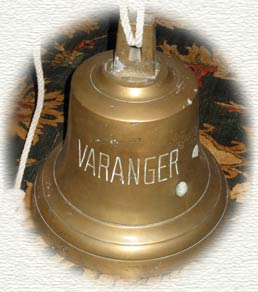| Site Map | Search Warsailors.com | |
|
M/T Varanger To Varanger on the "Ships starting with V" page. Manager: Westfal-Larsen & Co. A/S, Bergen Delivered in Febr.-1925 from Nederlandsche Scheepsbouw Mij., Amsterdam. Captain: Carl Horne. Related item on this website:
Her voyages are listed on these original images from the Norwegian National Archives: Please compare the above voyages with Arnold Hague's Voyage Record below.
(Received from Don Kindell - His source: The late Arnold Hague's database). Follow the convoy links provided for more information on each.
From the nephew of Martens Vernøy, who served as able seaman on board from Jan. 23-1940 to Aug. 31 that year, I've received the following (from his uncle's diary - his uncle's brother, Ole Vernøy, served on Berganger, Siranger and Narvik, and was torpedoed twice):
On Jan. 12-1941, we find her in the slow Convoy SC 19 from Halifax, bound for Clyde with fuel oil in station 54 of the convoy, getting praise for her station keeping (see the Commodore's notes for SC 19; an analysis of attacks is also available - see also Ruth I). The following month, she's listed in station 55 of Convoy OB 286, destination New York, where she arrived March 6, the convoy having been dispersed on Febr. 17. There's now quite a long gap in her record on Page 1, where departure New York is given as June 30. She arrived Halifax on July 4, and was scheduled to return to the U.K. in Convoy HX 137 from there on July 6, but instead joined the next convoy on July 11, HX 138, arriving Clyde July 27, continuing to Bowling the next day. Just a few days later, she can be found in the westbound North Atlantic Convoy ON 3. Her destintion is again given as New York, where she arrived Aug. 18, having started out from Clyde Aug. 1 (the convoy had been dispersed on the 14th). On Sept. 16, she joined Convoy HX 150 from Halifax in order to head back to the U.K. (the archive document gives her destination as Swansea), but went into Sydney, C.B. on the 18th, joining the slow Convoy SC 45 from there that same day. Judging from the archive document, it looks like she returned to Sydney again, but must have re-joined(?) - she arrived Clyde on Oct. 4. This convoy is not yet available among the SC convoys included in my Convoys section, but will be added. In the meantime, please go to the section naming ships in all SC convoys (several Norwegian ships took part). According to the external website that I've linked to below, Varanger subsequently joined Convoy OS 9 which left Liverpool on Oct. 13-1941. Voyage is given as Clyde to Curacao in ballast, station 85 (the Norwegian Annavore, Fagersten and Fjord are also named). However, she's also listed as bound for Curacao in Convoy ON 32, which originated in Liverpool on Nov. 1, so she probably did not sail in OS 9. Going back to Page 1, we learn that she arrived Aruba on Nov. 24, having sailed from Clyde on Nov. 1; A. Hague says she had detached from the convoy on Nov. 10 (ON 32 proceeded to Halifax). From Aruba, she later continued to Caripito, Freetown and Puerto la Cruz, and on Jan 11-1942, she left Puerto la Cruz for Curacao, with arrival Jan. 12 - her voyages in this period are shown on Page 2. More information on the other Norwegian ships mentioned here is available via the alphabet index at the end of this page, or go to the Master Ship Index. Related external link:
As mentioned above, Varanger had arrived Curacao from Puerto la Cruz on Jan. 12-1942. She left Curacao again for New York on Jan. 16 with 12 750 tons fuel oil. On Jan. 25 (at 03:00 according to a journal excerpt) she was torpedoed by U-130 (Kals), 38 58N 74 06W* (about 28 n. miles southeast of Atlantic City, N. J.). She was hit by 3 torpedoes and broke in three. (For info, this U-boat had sunk Alexandra Høegh just a few days before and Frisco earlier that month). The 1st torpedo struck on the port side between the foremast and the bridge where 2nd mate Wilhelmsen, the helmsman, Ordinary Seaman Brevik and the lookout, Able Seaman Karlsen were on duty. The explosion destroyed the port amidships lifeboat and rendered the radio useless. Her engine was stopped and all secret code books thrown overboard. The starboard amidships lifeboat and the starboard aft motorboat were ordered launched, and the former was on the water but the latter was only lowered half way when, about 5 minutes after the 1st torpedo had struck, a 2nd torpedo hit between the aft mast and the poop. A couple of minutes later, after everyone had gotten off and behind the ship, which at that time had started to sink, a 3rd torpedo set her on fire. The front part stayed above water (the attack happened close to land in about 140 ft. of water), while the other 2 parts sank.
All 40 had survived (2 of whom were American citizens) and as the U-boat surfaced they started to row westwards. The motorboat later took the lifeboat in tow. After about 6 hours they encountered 2 fishing vessels which towed the lifeboats to the Coast Guard Station at Sea Island Inlet, N.J., with arrival there at 12:45. A report from Lieutenant Gilbert L. Countryman, U.S.N.R. to Commandant Fourth Naval District, via Commander Inshore Patrol dated Jan. 25-1942 (based on survivors' statements, received from Tony Cooper, England) says that Varanger had departed Coco Solo on Jan. 16, and was about 30 miles offshore on a course toward Barnegat (38 58N 74 06W) when the first torpedo hit amidships on the port side at 03:10, destroying the radio equipment, closing hatches, blowing in plates, rendering the 4" gun inoperative and destroying 2 of the 4 lifeboats. As Varanger began to list and sink the crew crawled through holes blown in the plates to get out. The 2 remaining boats were launched and the men in the water were picked up. Each member of the crew wore an "Easco" lifejacket light (electric, waterproof) which enabled those in the boats to see them easily in the water. The 2nd torpedo, from another U-boat (? as far as I can determine, this is incorrect) hit on the port side at 03:17 and destroyed the engine room; all men were off the ship by then. At 03:22 a U-boat surfaced about 1 mile to shore while another(?) came in close and fired a torpedo which hit forward on the port side, whereupon the ship sank rapidly. At that time the 2 lifeboats were headed toward Ocean City. A plane was heard in the air but not seen. Fishing vessels towed them to shore, and the men were taken to Townsend Inlet. No one was seriously injured, though they all suffered from shock and exposure, some had minor lacerations and bruises. 1st Mate Arnfinn Krokeide had possible fractured ribs from having been thrown to the deck in the first explosion, though a civilian doctor in attendance was of the opinion that it was a severe bruise and not a fracture (excerpt from the ship's journal states he was admitted to a hospital in Philadelphia on Jan. 26). This report adds that requests of civilians to talk to crew members and take photographs were denied. The Red Cross were supplying necessary clothing and shoes, and immigration officials were enroute from Philadelphia. 1 crew member left the building by a cellar door but was returned by Coast Guard personnel. The maritime hearings were held in New York on Jan. 29-1942 with Captain Horne, the 2nd mate, Able Seaman Karlsen, and Ordinary Seaman Brevik appearing (position here is given as 30N 74 7W). In addition to Frisco and Alexandra Høegh already mentioned, U-130 was also responsible for the attacks on Grenanger, Tankexpress, Malmanger and Mirlo - follow the links for more details. I've received an E-mail from Joe Milligan who says that Varanger's history has been greatly detailed in several books published in the U.S. about shipwrecks. It appears to be a popular target for divers and many artifacts have been recovered. Varanger's bell was originally discovered on the wreck by a diver named Tom McElwee in 1978. He recovered the ship's helm during the late 1970's, while Joe Milligan recovered the bell in 1982 with his dive partner George Hughes. Joe also recovered the porthole, and he has framed a picture of Varanger inside it. (The picture was taken on Jan. 26-1942, the day after the sinking and shows her bow out of the water). Joe says, "She lies in 140 feet of water completely upright. The wreck has collapsed quite a bit over the past 10 years, however, it is still one of the best ship wreck dives on the east coast of the US".
Crew List:
Related external links: Back to Varanger on the "Ships starting with V" page. Other ships named Varanger: Norway also had a whale catcher by the name Varanger, built Oslo 1881 - this vessel was in service in Iceland till 1911. According to the Finnmarks Fylkesrederi og Ruteselskap fleet list by Finn R. Hansen a steamer by this name was delivered in July-1876 from Trondheim mek. Verksted to Brodtkorpfirmaet i Vadsø & Vardø, 113 gt. Sold in March-1916 to Finmarkens Amtsrederi, Hammerfest, no name change. Damaged in Aug.-1916 by Hurtigruten's Hera, repaired. Ran aground near Nesseby in 1917. Rebuilt in May-1922. Lost on Nov. 28 that year near Bugøynes, Sør-Varanger. Westfal-Larsen also had another tanker named Varanger, delivered in Febr.-1954 from Kockums, Malmö, 10 590 gt. Became Rougebrune of Monaco in 1968. Broken up in Spain 1976. A 3rd Varanger was delivered to this company in Nov.-1974, built at Kaldnes Mek. Verksted, Tønsberg, 21 284 gt, also a tanker. The text on this page was compiled with the help of: "Nortraships flåte", J. R. Hegland, "Sjøforklaringer fra 2. verdenskrig", Volume II (Norwegian Maritime Museum), and misc. others for cross checking details, some of which are named in the above narrative - (ref. My sources).
|
|||||||||||||||||||||||||||||||||||||||||||||||||||||||||||||||||||||||||||||||||||||||||||||||||||||||||||||||||||||||||||||||||||||||||||||||||||||||||||||||||||||||||||||||||||||||||||||||||||||||||||||||||||||||||||||||||||||||||||||||||||||||||||||||||||||||||||||||||||||||||||||||||||||||||||||||||||||||||||||||||||||||||||||||||||||||||||


